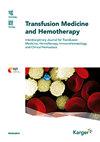CRISPR/Cas9-Editing K562 Cell Line as a Potential Tool in Transfusion Applications: Knockout of Vel Antigen Gene
IF 1.9
4区 医学
Q3 HEMATOLOGY
引用次数: 0
Abstract
Introduction: The Vel– phenotype is a rare blood group, and it is challenging for identifying this phenotype due to limited available reagents. Moreover, there are relatively few studies on genomic editing of erythroid antigens and generation of knockout (KO) cell lines at present. Methods: To identify the high-efficiency small-guiding RNA (sgRNA) sequence, candidate sgRNAs were transfected into HEK 293T cells and analyzed using Sanger sequencing. Following this, the high-efficiency sgRNA was transfected into K562 cells using lentivirus transduction to generate KO Vel blood group gene cells. The expression of the Vel protein was detected using Western blot on single-cell clones. Additionally, flow cytometry was used to detect the erythroid markers CD235a and CD71. Hemoglobin quantification and Giemsa staining were also performed to evaluate the erythroid differentiation of KO clones induced by hemin. Results: The high-efficiency sgRNA was successfully obtained and used for CRISPR-Cas9 editing in K562 cells. After limiting dilution and screening, two KO clones had either deleted 2 or 4 bases and showed no expression of the Vel protein. In the hemin-induced KO clone, there was a significant difference in erythroid marker and hemoglobin quantification compared to untreated cells. The morphological changes were also observed for the hemin-induced KO clone. Conclusion: In this study, a highly efficient sgRNA was screened out and used to generate Vel erythroid antigen KO single-cell clones in K562 cells. The edited cells could then be induced to undergo erythroid differentiation with the use of hemin.CRISPR/ cas9编辑K562细胞系作为输血应用的潜在工具:敲除Vel抗原基因
& lt; b> & lt; i>简介:& lt; / i> & lt; / b>Vel -表现型是一种罕见的血型,由于可用的试剂有限,鉴定这种表现型具有挑战性。此外,目前对红系抗原的基因组编辑和基因敲除(KO)细胞系的产生的研究相对较少。& lt; b> & lt; i>方法:& lt; / i> & lt; / b>为了鉴定高效小导向RNA (high-efficiency small-guiding RNA, sgRNA)序列,我们将候选sgRNA转染到HEK 293T细胞中,并使用Sanger测序进行分析。随后,利用慢病毒转导将高效sgRNA转染到K562细胞中,生成KO Vel血型基因细胞。用Western blot检测单细胞克隆中Vel蛋白的表达。流式细胞术检测红细胞标记物CD235a和CD71。血红蛋白定量和Giemsa染色评价血红素诱导KO克隆的红系分化。& lt; b> & lt; i>结果:& lt; / i> & lt; / b>成功获得高效sgRNA,并将其用于K562细胞的CRISPR-Cas9编辑。经过有限稀释和筛选,两个KO克隆缺失了2个或4个碱基,没有表达Vel蛋白。在血红素诱导的KO克隆中,红细胞标记和血红蛋白定量与未处理的细胞相比有显著差异。血红素诱导的KO克隆在形态学上也发生了变化。& lt; b> & lt; i>结论:& lt; / i> & lt; / b>本研究筛选到高效的sgRNA,用于在K562细胞中生成Vel红细胞抗原KO单细胞克隆。然后利用血红素诱导编辑后的细胞进行红系分化。
本文章由计算机程序翻译,如有差异,请以英文原文为准。
求助全文
约1分钟内获得全文
求助全文
来源期刊
CiteScore
4.00
自引率
9.10%
发文量
47
审稿时长
6-12 weeks
期刊介绍:
This journal is devoted to all areas of transfusion medicine. These include the quality and security of blood products, therapy with blood components and plasma derivatives, transfusion-related questions in transplantation, stem cell manipulation, therapeutic and diagnostic problems of homeostasis, immuno-hematological investigations, and legal aspects of the production of blood products as well as hemotherapy. Both comprehensive reviews and primary publications that detail the newest work in transfusion medicine and hemotherapy promote the international exchange of knowledge within these disciplines. Consistent with this goal, continuing clinical education is also specifically addressed.

 求助内容:
求助内容: 应助结果提醒方式:
应助结果提醒方式:


